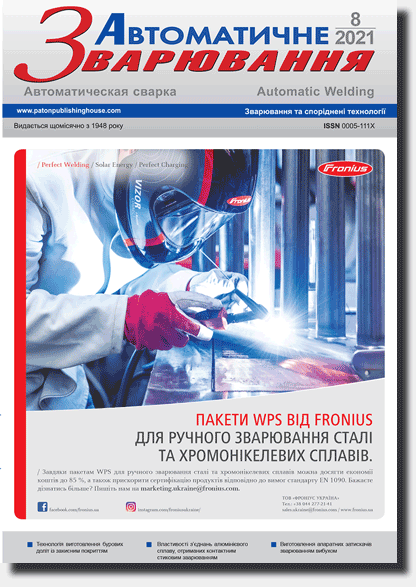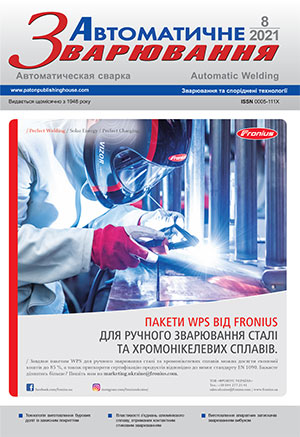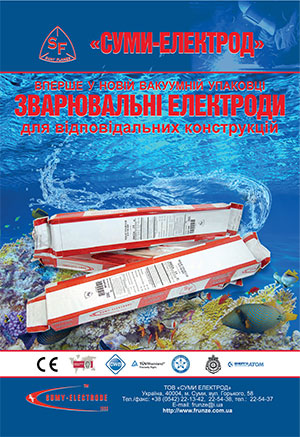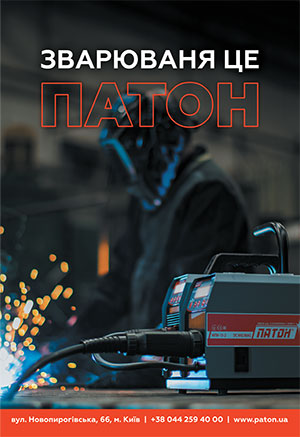| 2021 №08 (07) |
DOI of Article 10.37434/as2021.08.08 |
2021 №08 (09) |
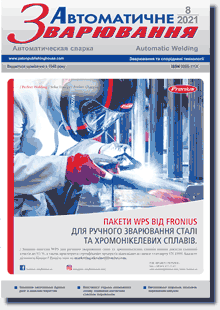
"Avtomatychne Zvaryuvannya" (Automatic Welding), #8, 2021, pp. 41-46
Development of the technology of manufacturing hardware clamps, using explosion welding
L.D. Dobrushin, A.G. Bryzgalin, P.S. Shlonskiy, E.D. Pekar, S.D. Ventsev
E.O. Paton Electric Welding Institute. 11 Kazymyr Malevych Str., 03150 Kyiv, Ukraine. E-mail: office@paton.kiev.ua
Joining copper and aluminium current-conducting elements is quite often applied in electrical industry. Direct contact of such elements without welding is accompanied by running of electrochemical corrosion and resultant increase of transient resistance, which rises during operation. Any kind of welding these materials leads to formation of intermetallics of AlnCu type, which can affect (or not affect) the electrical properties of the joint. Explosion welding is the most efficient method to produce copperaluminium electric conductors with higher performance. The need to manufacture bimetal copper-aluminium products of various shapes by explosion welding requires development of the respective technological processes. 4 Ref., 5 Tabl., 10 Fig.
Keywords: electric conductor, electric resistance, bimetal transition piece, composite joint, explosion welding, copper-aluminium transition piece
Received: 03.07.2021
References
1. Ryzhov, S.B., Zubchenko, A.S., Kashirsky, Yu.V., Banyuk, G.F. (2004) Steels and alloys of power engineering equipment. Moscow, Mashinostroenie [in Russian].2. Lysak, V.I., Kuzmin, S.V. (2005) Explosion welding. Moscow, Mashinostroenie [in Russian].
3. (2008) Non-ferrous metals and alloys: Refer. book. Moscow, Mashinostroenie [in Russian].
4. Konovalov, D.A., Veretennikova, I.A. (2028) Study of mechanical properties of bimetal produced by explosion welding at step-by-step plastic deformation. Pisma o Materialakh, 8(2), 215-219 [in Russian]. https://doi.org/10.22226/2410-3535-2018-2-215-219
Advertising in this issue:
The cost of subscription/purchase order journals or individual articles
| Journal/Currency | Annual Set | 1 issue printed |
1 issue |
one article |
| TPWJ/USD | 384 $ | 32 $ | 26 $ | 13 $ |
| TPWJ/EUR | 348 € | 29 € | 24 € | 12 € |
| TPWJ/UAH | 7200 UAH | 600 UAH | 600 UAH | 280 UAH |
| AS/UAH | 1800 UAH | 300 UAH | 300 UAH | 150 UAH |
| AS/USD | 192 $ | 32 $ | 26 $ | 13 $ |
| AS/EUR | 180 € | 30 € | 25 € | 12 € |
| SEM/UAH | 1200 UAH | 300 UAH | 300 UAH | 150 UAH |
| SEM/USD | 128 $ | 32 $ | 26 $ | 13 $ |
| SEM/EUR | 120 € | 30 € | 25 € | 12 € |
| TDNK/UAH | 1200 UAH | 300 UAH | 300 UAH | 150 UAH |
| TDNK/USD | 128 $ | 32 $ | 26 $ | 13 $ |
| TDNK/EUR | 120 € | 30 € | 25 € | 15 € |
AS = «Automatic Welding» - 6 issues per year;
TPWJ = «PATON WELDING JOURNAL» - 12 issues per year;
SEM = «Electrometallurgy Today» - 4 issues per year;
TDNK = «Technical Diagnostics and Non-Destructive Testing» - 4 issues per year.





